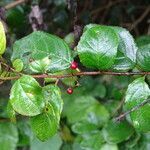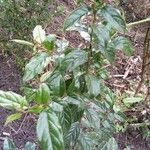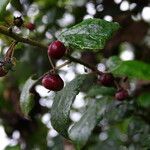Shrub or small tree, 1-8 m high. Leaves alternate or opposite, simple, petioled, toothed; stipules small, deciduous. Flowers mostly bisexual, in axillary cymes or racemes. Calyx urceolate or flat; lobes 5, deltate, erect or spreading. Petals 5, cucullate or flat. Disc inconspicuous, lining calyx tube. Stamens 4 or 5, shorter than calyx lobes. Ovary superior, sometimes immersed in disc, 3-or 4-locular; styles 3-or 4-fid. Fruit a slightly fleshy drupe, red to purple-black when ripe, turbinate. Seed 3 or 4, obovoid.
Evergreen shrub or small tree, sometimes scrambling, up to 5 m high. Leaves with blade elliptic or elliptic-oblong, 30-100 x 15-40 mm, upper surface dark green, shiny, margins crenate or serrate, pinnately nerved. Flowers: small, axillary, 5-merous; corolla green; Nov.-Jun. Fruit a 2-or 4-locular, fleshy, shiny drupe, dark red to black when mature.
Leaves alternate; lamina 3–10 × 1·5–4 cm., elliptic or oblong-elliptic, apex acute or acutely acuminate, margin serrulate, base cuneate or rounded, glabrous, shining, with nerves impressed above, pubescent on nerves below, tertiary venation conspicuous; petiole 3–10 mm. long, pubescent; stipules subulate, up to 5 mm, long.
Shrub or small tree, sometimes scrambling, up to 5 m high. Leaves penninerved, usually crenate or serrate, lamina elliptic or elliptic-oblong, 30-100 x 15-40 mm. Fruit 2-4-locular, a fleshy drupe. Flowers 5-merous; green.
Shrub or small tree to 7 m. Leaves elliptic, serrate, glossy above. Flowers in axillary fascicles, greenish. Fruits thinly fleshy, turbinate, red to black.
Shrub or small tree, sometimes scrambling; bark blackish, often with many lenticels; young branches pubescent, glabrescent with age.
Inflorescence a sessile axillary 2–10-flowered fascicle; pedicels 2–7 mm. long, puberulous.
Fruit turning through red to purple-black when ripe, c. 5 mm. in diam., slightly fleshy.
Ovary 3(4)-locular; ovules 1 in each loculus; style 2 mm. long, 3(4)-fid.
Petals 5, small, spathulate, hyaline or absent.
Sepals 5, deltate, c. 2 mm. long.
Stamen-filaments 1 mm. long.
Receptacle puberulous.
Disk 2·5 mm. in diam.
Seeds 3–4, obconic.



